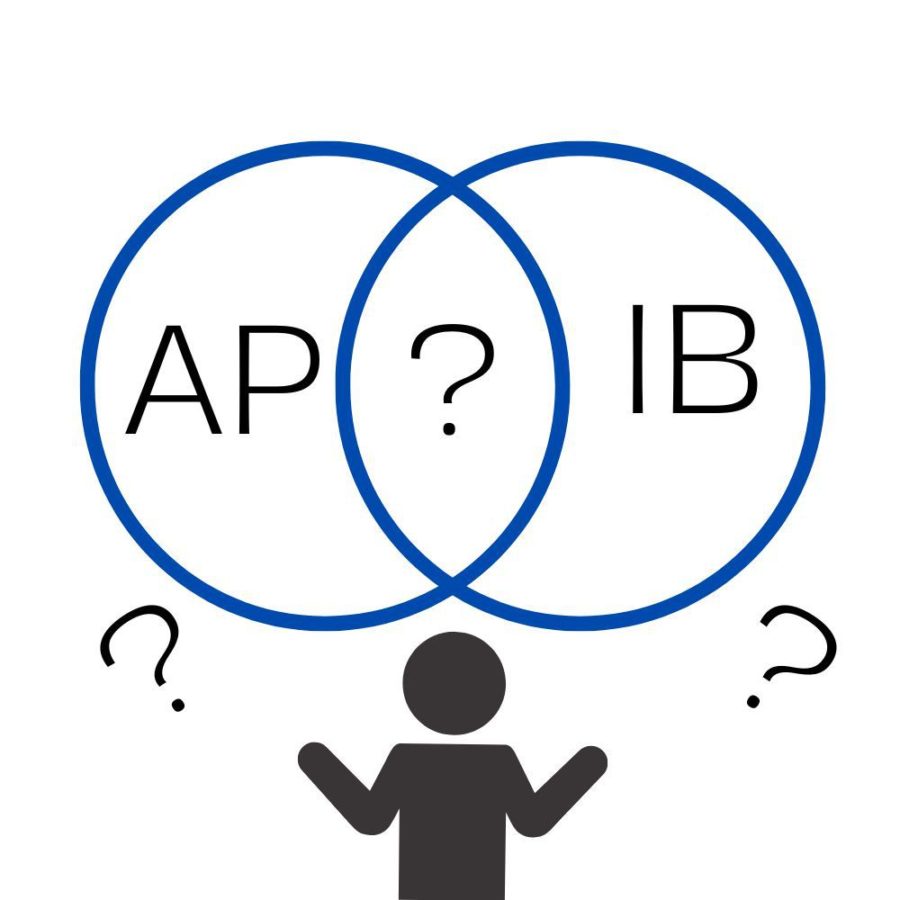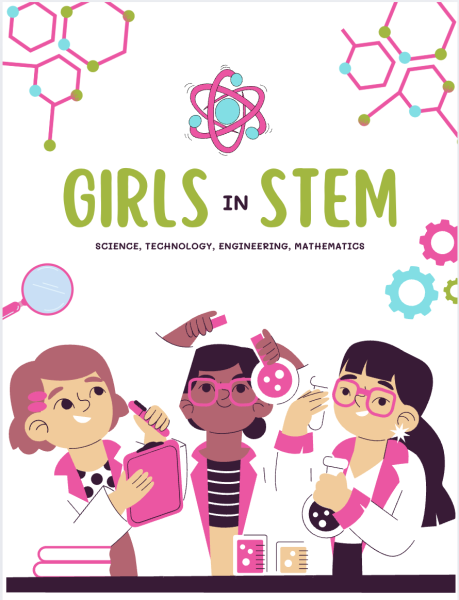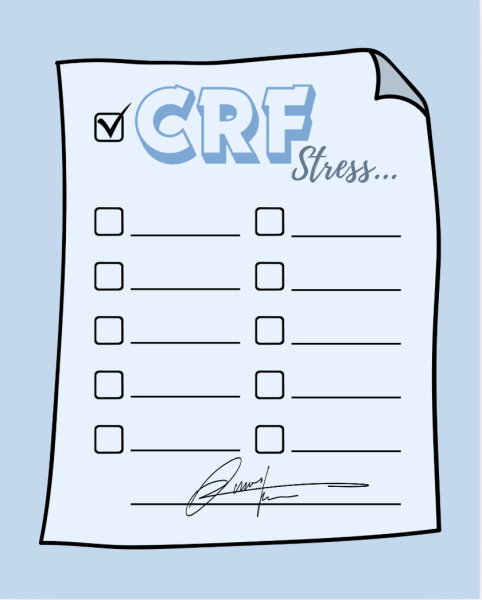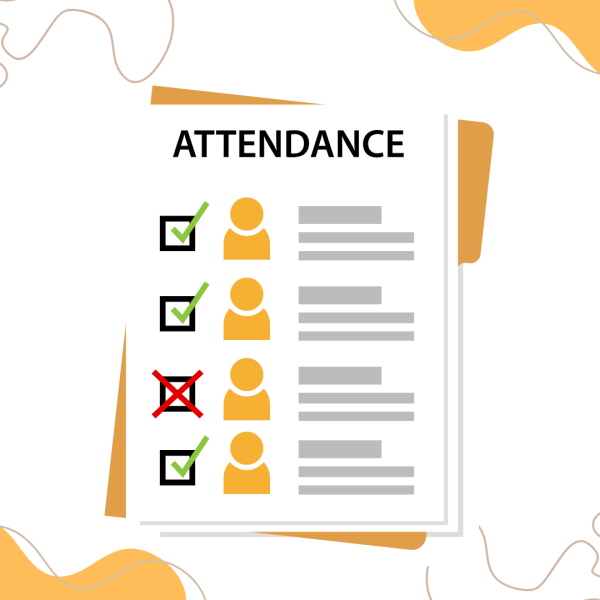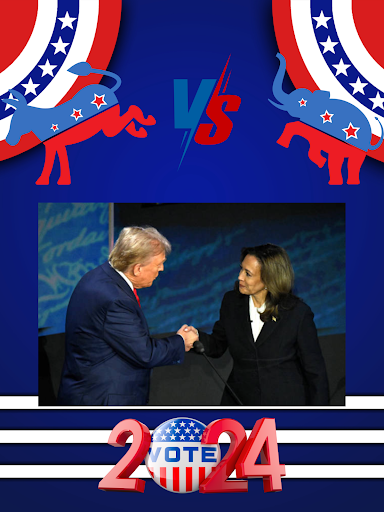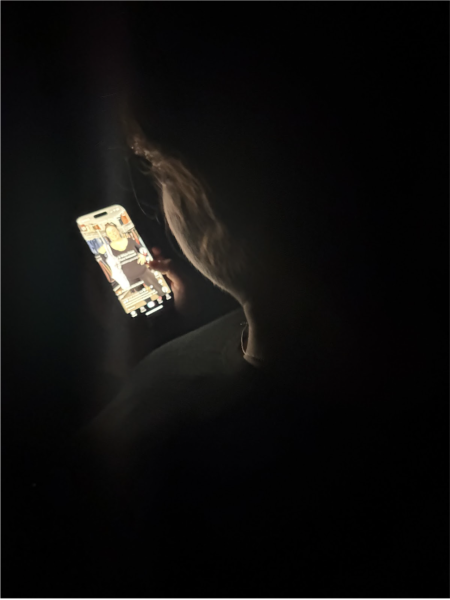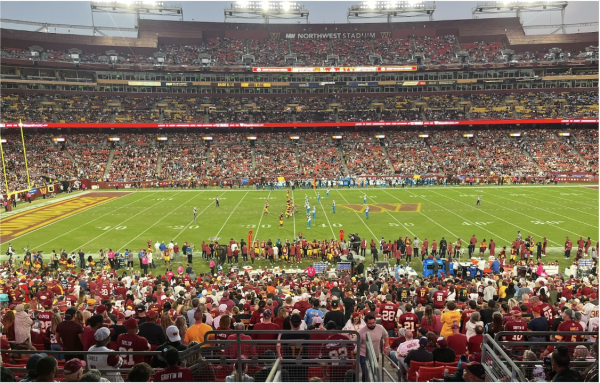To (I)B or not to (I)B
Distinguishing the schools most challenging AP and IB classes
While the second semester has only just begun, brightly colored cardstock dotting the hallways suggests that attention has already shifted to the 2023-2024 school year. For current sophomores, their selections on course request forms (CRF’s) this February may determine their junior and senior year schedules due to the nature of International Baccalaureate (IB) classes. Therefore, making an informed decision is important for success as an upperclassman. For students hoping to challenge themselves, many eyes turn immediately to the school’s wide-ranging list of Advanced Placement (AP) and IB classes (in several cases, there is also a difference between the Standard Level (SL) IB classes and the Higher Level (HL) IB classes). Despite a shared subject umbrella and air of prestige, there are differences between these programs. Some students may thrive in an AP environment, while others prefer IB. Others may learn differently depending on the subject. It is critical to know what one is getting themselves into before checking the box on a CRF.
Biology:
Building on principles established in freshman year biology (bio) classes, the IB HL Biology and AP Biology classes center around the same topics.
“[There is] lots of overlap,” Ms. Lourdes Sotomayor, who teaches HL Biology part two and Intensified Biology, said. “I would say that there are certain specifics that are only true for AP Bio and only true for IB Bio, but still, most of the content overlaps.”
“There’s a lot of lab work in AP bio, and there’s also a lot of focus on modeling systems in biology,” Ms. Dawn McCoart, who teaches Intensified and AP Biology said. “Modeling cell respiration, cell membranes, that kind of thing.”
The typical motive when choosing one version or the other is scheduling. HL Biology is taught over two years, while AP Biology is taught as a double block in one year, meaning it takes up two full class periods.
“AP Bio is one year… but it covers what would be comparatively HL one and HL two material that’s covered in two years, it covers it in one year,” Ms. Sotomayor said. “If you don’t have two years to take part one and part two of IB Bio, then you can take one year AP Bio with a double block… it’s all about the scheduling.”
College and college credit is the other distinguishing factor. Doing well on the AP exam can mean receiving up to eight college credits. This is because AP Biology is equivalent to “Biology 101,” a two-semester course at most colleges.
“If you’re going for the IB diploma and you want to study overseas [or at an] international school, it would make a lot of sense to take the IB Bio class,” Ms. Sotomayor said. “The AP Bio class is, if you do well on the exam, accepted as college credit.”
There is a one-year, single-block SL Biology class for students that do not have room for either a double block or a two year course. Combined with HL part one, the SL class only covers half of the material. While the course does offer a quality point, it does not count towards the full IB diploma or offer college credit.
“If your schedule permits and you like [the class] as a junior taking SL, you can then take HL 2 next year, and they’ll change the classification of SL to HL one.” Ms. Sotomayor said.
HL and AP Biology come with a heavy workload including reading, notes and lab write-ups.
“[In AP Biology] I’ve sort of flipped the classroom so [students] watch videos and take Cornell notes. I have a very intricate notebook that they have to do,” Ms. McCoart said. “Then we come in and do some lab or activity based on that information or if it’s more complex we go over that information again and then do the activity… Then they have to study for their tests and they do have to read parts of their textbook.”
“[IB Biology students] have to read the textbook, and I give them some guided notes that goes along with the reading so that as they read they can prepare their notes,” Ms. Sotomayor said. “Sometimes they have additional online assignments that they complete digitally. Then there are labs–sometimes there are write-ups for the labs, sometimes there aren’t– [and] studying for testing.”
Finally, the course concludes with different assessments. The AP Biology test consists of 65 multiple-choice questions and eight free-response questions. Two of these questions are more extended, taking around 20 minutes each, while the other six take between three and seven minutes each.
The IB exam consists of four components. Students complete papers one and two on day one. Paper one is multiple choice, while paper two consists of database free-response questions. The next day students take paper three, which is largely based on an optional topic that students have picked and studied. This paper also includes a choice of extended response questions. Finally, 20% of a students final score is the Internal Assessment (IA) which students write in the first year of the course. This is an independent research paper similar to the ones written in preparation for the science fair. An underclassmen’s experience with science fair is thought to be worthwhile for many reasons, such as writing and analytical skills, but another one of these reasons is its usefulness in preparing students for potentially writing an IA.
English:
The standard and advanced diplomas require four years of English classes in high school. Following ninth and tenth grade, several pathways exist to achieve this requirement, including AP English classes. The school offers AP English Language and Composition (only offered to juniors) and AP English Literature (only offered to seniors).
“[AP] Language and Composition is more nonfiction [material] and focus on rhetoric, … the art of speaking and writing effectively,” Mrs. Sarah Becker, who currently teaches HL English part two and has taught AP Language and Composition in the past, said. “I find that students who are of all interests academically can really appreciate the language class because it feels cross-curricular in the skills application… My students who are really STEM oriented that I’ve had in the past have really appreciated the AP Language class.”
In addition, the school offers IB English at both an SL and HL level, known as IB Language and Literature and IB Literature, respectively. Both courses are two years in length and include an IB exam which consists of a spoken oral and a timed paper one and paper two at the end of part two. HL English also consists of an essay written toward the end of part one.
Content-wise, SL English is often compared to the AP Language and Composition class, while HL English is more similar to the AP Literature class.
“[The IB SL Language and Literature class and AP Language and Composition classes include] lots of different types of things that you read and types of material,” Mrs. Becker said. “It’s not as much a traditional literature class like our IB English HL classes. With [IB Language and Literature] it’s more a variety of types of texts… It’s similar to the AP Lang class.“
The HL and AP literature classes focus on the content of these more traditional novels. SL English and AP Language classes focus on the presentation of the content.
“[In AP English Language] there’s just a complete focus on the purpose,” Mrs. Becker said. “It’s perfect for kids who are interested in [something like] politics… being able to use that skill set… It gives you a different lens to think critically.”
While the content of these AP and IB courses may be similar, they culminate in very different tests. In contrast to the essays and oral presentations of IB, both AP tests consist of a one-hour multiple choice section followed by three essays (on varying topics) written in 120 minutes.
“I chose to do IB instead of AP when I was in high school because the timed nature of the AP exam was difficult for me,” Mrs. Becker said. “If you know that you prefer to have a little more time and to process certain things, then [an IB class] might work better for you.”
Of course, both classes are full of the necessary preparation. IB English heavily focuses on presentations leading up to the individual oral, while AP English tends to be more writing-focused, consisting of many timed writings. Mrs. Becker has seen these writings pay off for her students.
“One of the best compliments I ever got about [the AP Language and Composition] course, not [about] me but the course itself, was about how they felt after taking that class in general; they never had writer’s block … because they felt like they could just ‘get started.’” Mrs. Becker said.
Both IB classes lock students in for a full two years, and a student cannot switch from SL to HL or vice versa. However, a student does not have to take both AP classes. Dual Enrollment allows students to earn college credit without a test (like the AP exam), and grade-level English is also an option.
“You could take English Eleven, you could take Dual Enrollment Eleven or you could take AP Eleven or you could take none of those things and then take AP Twelve, or not,” Mrs. Becker said.
Math:
The school offers both IB HL and IB SL math classes as well as AB Calculus and BC Calculus. The school combines SL part one and Intensified Pre-Calculus. Students in SL part two are in class with either AB or BC Calculus students (AB and BC calculus classes do not combine). HL part one is the same class as BC Calculus, and therefore SL part two.
“The big difference is AP is one subject,” Ms. Zarro, who teaches IB SL Math part one, IB HL Math part two and AP Calculus AB, said. “The AP test would just be AP Calculus, only calculus, or AP Statistics is only statistics. Whereas the IB tests are more the international [approach]. Like when you hear British people, they say ‘maths’ because math isn’t one subject, math is multiple subjects. So they’ll say ‘maths’, and that’s what the IB test is. The IB test does have calculus on it, but it also has statistics. It also has trigonometry. It also has algebra. It really encompasses everything from Algebra One through Calculus, and there’s a little bit of everything on the test.”
Due to this, most of the material covered in either AP Calculus class could appear on an IB exam. SL Math part one covers the other areas of the test while also providing building blocks for calculus, which is useful to non-IB, pre-calculus students.
“There’s five main topics that are included [on the IB Math exam],” Mr. Zarro said. “Calculus is one of the six topics, so that’s why for the IB, we don’t separate out the calculus students. We want them to learn that full year, of calculus because that matches more what you’re going to see in an American school which is where the vast majority of our kids go. So if we just taught what was on the IB exam, like the SL level, you would have the first three weeks of calculus in college, but you wouldn’t have a full calculus course.”
Several topics appear only on the AP or only on the IB exam, but for the most part, the courses are similar enough. Students taking IB Math also can sit for the AP exam (however, they have to pay for it themselves) at the end of the year. As they have learned all of the material, this may make college credit more attainable at schools that do not accept IB credits.
SL part one is combined with the Intensified Pre-Calculus course. While these students learn the same material throughout the year they do not have to write an IA (a paper which explains applying a learned math topic to the real world) and therefore do not receive a quality point for that year. Other pre-calculus options include Dual Enrollment Pre-Calculus, Grade-Level Pre-Calculus, and Algebra Three.
“If you want to go to BC Calculus, even if you’re not IB, you should go through IB SL one [coded as Intensified Pre-Calculus] because it takes the same pre-calculus topics that Dual Enrollment does, but at the intensified level. So they’ll ask questions that are deeper or more application questions, like taking the knowledge and applying it, and it moves at a faster pace,” Ms. Zarro said. “BC [Calculus] moves faster than AB [Calculus], so it’s kind of designed as the intensified course to get you ready for the harder calculus course, whereas Dual Enrollment is more geared towards preparing for AB Calculus.”
Some students are ready for IB SL part one as a sophomore. These students can switch to HL Math in their junior year, completing the course as a senior. While similar, this course goes deeper into topics covered in SL Math. Students could take HL Math without the year of SL, however it is difficult due to expected prior knowledge on IB SL part one topics.
On the other hand, students looking for a slightly easier challenge may enjoy IB Math Applications and Interpretations (A and I). This is a one year course which focuses more heavily on statistics, IB SL part one (Analysis and Approaches (A and A)) focuses more on algebra, trigonometry, calculus, and some statistics.
“For students who want an advanced course but the traditional math courses aren’t their strength, [A and I] tends to be another option,” Ms. Zarro said. “I feel like IB has the path to an advanced course, but an easier advanced course… A and I is hard, but it’s a different way of thinking so some students benefit from that.”
Psychology:
The IB diploma program requires taking six IB classes across six different subject areas.. Many IB students choose to fill the sixth spot with classes such as IB Psychology (psych) or Social-Cultural Anthropology. While this is a second class in the “Individuals and Societies” (second to history) category, it is a permissible replacement for the “arts” category per the IB website. Whether or not a student is full IB, AP and IB Psychology are popular electives.
“The IB class is available as a two-year class [HL] or a one-year class [SL],” Mr. Robert Byrnes, who teaches both IB Psychology classes and has taught General Psychology in the past, said. “What I see is that I have a lot of juniors that will take it as the two-year class, or I’ll have seniors take it as the one-year… Year one, both sections are together, and if you really like the class… by November [SL/one year students] could switch into the higher level class without penalty.”
The school also offers AP Psychology. This is a one-year course that culminates in the AP exam, made up of a multiple-choice section and several free responses.
“I think the studying is very different for [AP and IB Psychology] because you have so many facts with the AP exam… different names and [things like] the direction for, say, operant conditioning,” Mr. Byrnes said. “Meanwhile, for IB psych, you’re trying to fit studies to particular ideas.”
It is also possible for students to take both AP and IB Psychology over their four years. Some students have room for AP Psychology as a sophomore, and Mr. Byrnes estimates a 30% overlap between the two classes.
“If I was speaking to a [rising] sophomore, I would advise them to take AP Psych,” Mr. Byrnes said. “If they really enjoyed it, then they should take IB Psychology… A way that they can do that is by taking [Economics and Personal Finance] over the summer as a virtual course… that really opens up people’s schedules.”
There are differences between AP and IB Psychology. AP is more of a broad overview, while IB focuses in depth on fewer subjects. For example, AP Psychology teaches students every part of the brain, while IB learns about specific parts of the brain by looking at and applying different studies.
“I envision AP Psych as like the greatest hits of psychology,” Mr. Byrnes said. “You’re exposed to some of the quintessential studies and ideas of psychology… interesting topics like perception, dreams, and then behavioral psychology. It’s a great intro class for psych. Meanwhile, IB Psych is like getting a full album. You are getting a more complete story about a topic. There are still the hits on the album, but you’re also getting the lesser known tracks. We go into more depth and it’s like a deep cut on an artist. We cover topics such as criminology, memory, love and stress.”
Finally, mainly due to the exam nature, the AP class requires more memorization throughout the year. IB Psychology is more writing-based and includes an IA, where students conduct a psychological experiment throughout the school.
“I believe that AP Psych involves a little bit more quizzes and testing throughout the year because it’s more factual and there’s more multiple choice involved,” Mr. Byrnes said. “IB Psych is not really a multiple choice class. It is a short answer class. A lot of our work can be obtained through homework assignments where you may write a short answer paragraph.”
History:
Junior year, the majority of students choose between taking IB History of the Americas (HOA) (junior year) and IB Topics (senior year) or AP US History (APUSH), a one-year class offered to juniors. APUSH begins in 1491 (pre-Columbus) and continues chronologically until the modern day. On the other hand, HOA and Topics go in-depth on just a few topics, bouncing between various time periods as the course continues. For example, HOA focuses on the civil war (beginning with causes and continuing through reconstruction) for most of the first semester.
“There’s a lot of content in AP US History, and I think that’s why a lot of students struggle in it. It’s a ton,” Ms. Christina Steury, who teaches APUSH and AP Consult, said. “We just talked about the civil war, and I have to decide, ‘what do I really want them to get out of it?’ Because we can’t study it for weeks… we study the content for maybe a day.”
Therefore, APUSH includes a lot of reading. Students often read the textbook at home. Sometimes, students must complete a notes packet and take a reading quiz in class. Ms. Steury also works to have group work/discussion in class and lots of practice with short answer questions to prepare for the AP exam.
“The first part of the exam is 55 multiple choice questions … it’s timed and they’re stimulus-driven,” Ms. Steury said. “Then we have three SAQs or three short answer questions. Two of them have excerpts or some other type of stimulus and then the final SAQ is really just a comparative question… Then they take a break and then come back to the 60 Minute DBQ and then the 40 Minute LAQ (long answer question).”
As most of the questions are stimulus-driven, the goal of the course is to make connections. For example, a student can understand the impact tariffs have had throughout history rather than the ins and outs of one specific tariff. However, this requires covering a lot of content in just one year.
For students who would like extra support in the class, AP Consult is a pass/fail class where students can work on skills necessary for APUSH. This is important as the writing style is different than in AP Government, which most students take sophomore year. AP European History and AP World History are said to be better preparation for the class.
On the other hand, the IB History exam is completely writing-based and occurs after part two. A large portion of the class is discussion based on reading done beforehand. Group projects and essay practice for the exam make up a significant portion of a student’s grade.
“We try to structure the class similar to college,” Ms. Jennifer Dean, who teaches IB HOA and Topics, said. “This isn’t a class where you’re gonna get a bunch of busy work. There’s consistent homework in the form of reading things and preparing for class. We ask questions and engage with [the reading] and do stuff in class, [we] make posters, have debates with classmates, stuff like that. So the grades are participation, and your in-class essays that we do in class. It’s more like a college class where there’s a fewer number of grades.”
Many students choose to take IB History because they are interested in going deeper and exploring topics they may not have seen before. In addition to the civil war, students study events such as the Mexican Revolution (part one) and the Cold War (part two).
“I think it’s a pretty cool class because it lets you go pretty deep into some really interesting topics, some of which students might be familiar with, things like the civil rights movement, for example, and others that they probably don’t have a lot of knowledge of, like the Mexican Revolution, or the Cold War,” Ms. Dean said. “ We don’t cover as many topics as an AP class that has to go from beginning to end. We can spend a lot of time on those different topics and look at them and really understand the history.”
Most students at the school completed one of their four required history classes in eighth grade. Therefore, students who choose to take the two-year class (HOA and Topics) do so because they are genuinely interested in the subject areas and therefore end up succeeding in the class. To earn an IB credit for the course, students must take both HOA and Topics over two years. There is no one year IB History option at the school. In most cases, students taking APUSH are not required to take a history class senior year.
“Usually we get positive feedback from the students at the end,” Ms. Dean said. “They do well on the exam, they’re very well prepared, they’ve enjoyed the class.”
Physics:
By junior year, most students have taken a year each of Biology and Chemistry. Many see physics as a way to round out the high school science experience, and as such, the school has several options for students, including General Physics, IB Physics SL and AP Physics. IB Physics is a two-year course over junior and senior years while general and AP Physics can be done in one year. For those interested, there is a second AP Physics class (AP Physics C) which is more advanced and often taken after completing either General Physics or AP Physics one. AP Physics one can also be taken following General Physics.
“[AP Physics is] not an easy class,” Mr. Gerson Pereira, who teaches AP Physics one and AP Physics C, said. “It’s gonna be kind of demanding at times because you haven’t been exposed to all these topics. Maybe you did take [general physics] prior, it’s [still] a big leap between general and AP level. We don’t offer an honors class here,so it’s a significant increase in level.”
IB SL Physics, on the other hand, is an alternative to General Physics.
“The content of the topics are actually very similar between IB Physics year one and General Physics,” Mr. Christopher Cook, who teaches IB SL Physics part one and General Physics, said. “There’s a lot of the traditional mechanics topics early on. Near the end of the year, IB Physics tends to go a little bit further into the physics curriculum. In that it will start to explore circular motion, you’ll start to explore not just energy but energy sources, and we’ll also get into thermodynamics. Then, IB Physics SL continues in year two with more advanced topics.”
Furthermore, IB Physics SL tends to offer more complex versions of problems and lab work.
“There’s a little bit of difference in terms of the level of challenge in problem-solving in IB Physics versus General Physics,” Mr. Cook said. “There’s also a significant difference in the lab investigations in terms of the amount of analysis and write ups that are required.”
In-depth lab write-ups are a cornerstone of IB SL Physics part one as they prepare students to write an IA of the same format on a physics topic of their choice during part two. General Physics tends to have more frequent labs and more freedom in other projects throughout the year as they do not have to write an IA or adhere to the IB standards.
“IB Physics in particular, because this is kind of the IB way, is about helping students to see the holistic aspect of a particular topic in terms of how it relates to the world beyond just
physics itself,” Mr. Cook said. “It certainly shows itself when we take a look at raw energy sources… We’re talking about the difference between renewable versus nonrenewable energy sources. It’s certainly a topic of interest, but beyond just physics [it has] economic impacts.”
In AP Physics, Mr. Pereira has “flipped” the classroom. Students watch videos at home, then come in for discussion, reading and practice, which leads to increased exposure over a short amount of time.
“If you Google, ‘what’s the most difficult AP class?’ It’s [an] AP Physics one,” Mr. Pereira said. “[Due to] the way that the course is built we have to go at a certain pace. I wish we didn’t at times so that everyone can enjoy physics because of that May deadline we have to cover quite a bit of material in such a way that it’s thorough [at a fast pace].”
The “May deadline” refers to the AP exam. This test consists of multiple-choice and three free-response questions. As with the IB exam, the AP exam provides students with formulas, therefore; the importance lies in the application.
“The correct answer may only be 1/4 of the points for that particular problem, if at all,” Mr. Pereira said. “It’s the process. Showing your work and showing the methods– how you got there– is the key to getting the maximum amount of points on the AP test.”
Languages:
By sophomore year most students have decided on a foreign language which they will continue through graduation. Many have spent years with this language, some even since elementary school, and are ready to pursue it at a high level. While the paths and courses differ slightly based on language, there are commonalities linking the schools’ IB and AP Language courses. The school offers AP and IB classes in Spanish, French, Latin, Arabic and Chinese. German, Japanese and American Sign Language do not have these advanced options.
Spanish is the most popular language and the only IB language class which separates SL and HL students. Furthermore, the school also offers an IB Language A, Spanish Literature, for completely fluent students. This is a similar format to most IB English classes.
“SL [Spanish] includes discussion of topics, reading articles, writing, listening, speaking all of the different tasks that you do in a language, but it does not include literature. The IB exam does not include literature. You can include it in your classes and some teachers read books or read short stories but it’s not part of the curriculum,” Ms. Lilliana Mendez, who teaches IB HL Spanish B, said. “HL A is a literature class, so it includes a lot of reading. HL B, which is what I teach, includes literature but it’s also articles, discussions and different things. HL B is a mix of SL and HL A.”
Generally, IB Language exams include four parts: reading, writing, listening comprehension, and speaking. The speaking section is typically done as a one-on-one “oral exam” with a teacher in the winter of part two, while the other three occur in a typical exam format in May. The oral exam includes a presentation from the student followed by a few minutes of question and answer.
“[In class] we do reading, we do discussions, we do debates, we do projects, we do presentations, we do listening exercises, we do writing exercises,” Ms. Mendez said. “Basically, let’s use the language in as many possible ways as we can.”
In Spanish classes, many students take AP Spanish sophomore year and may choose to progress to IB Spanish as an upperclassman. Teachers will provide a recommendation for students that did not take this path.
“We encourage the kids, if you did well in AP you’ll do well in IB so keep going, you never stop learning a language,” Ms. Mendez said. “Just keep going. You’ll get college credit and you improve. But you don’t have to do anything.”
On the other hand, French students must choose between AP and IB. While the AP class is a one-year course, it combines with French Five, which many students are encouraged to take before the AP class. Ms. Danielle Karaky, who teaches AP French and French Five, advises her students on whether or not they should take the AP exam after one year.
“I prepare for the test and all the parts of the test, but it’s [about] how well [students] are scored,” Ms. Karaky said. “I give them my honest opinion, if they are able to score at least three or four and they don’t have time in their schedule for more than one year, I tell them, ‘Okay, you can take the AP exam in one year.’ If not, I strongly advise for two because, naturally, if you are in a class for two years, your fluency is going to be much better and your writing is going to improve your reading skills are going to be faster.”
The IB and AP French classes revolve around the same six themes. However, IB French chooses two or three to go in-depth with, while the AP course covers all six. Ms. Karaky teaches the class in a “circular” way, covering three topics each year so that after taking French Five and AP French, a student will have been exposed to all six topics.
The AP exam has the same sections as IB (reading, listening comprehension, writing, and speaking). However, instead of a one-on-one oral presentation overseen by the teacher, the speaking section is recorded in about two and a half minutes on the day of the three-and-a-half-hour AP exam. Ms. Karaky has no control.
“Most of my students would report that [the AP exam] is pretty easy because we practice a lot in class for all the parts of the exam,” Ms. Karaky said. “[However], the time, after three hours and a half sitting, they get really exhausted at the end and the reading [section] is too fast. So they say it’s easy, it’s not that hard, but the time… it’s a very long exam, and tiring.”


